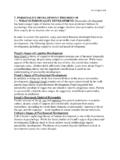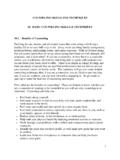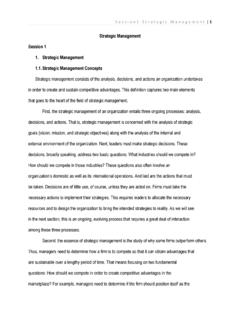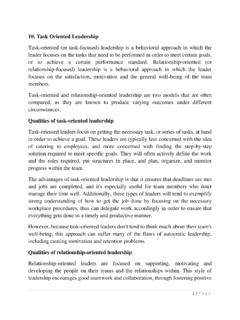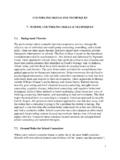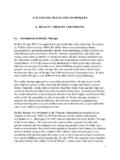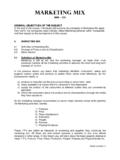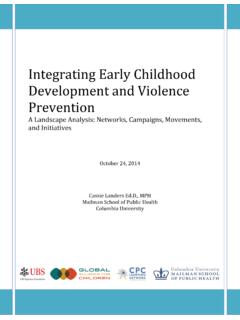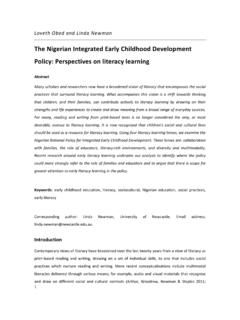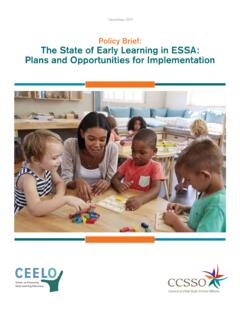Transcription of EARLY CHILDHOOD DEVELOPMENT THEORIES
1 1 | Human Growth & DEVELOPMENT EARLY CHILDHOOD DEVELOPMENT THEORIES GENERAL OBJECTIVES OF THE SUBJECT At the end of the course, Individuals will analyze the elements of the communication and will explain the basic principles of this course. 3. EARLY CHILDHOOD DEVELOPMENT THEORIES Abstract Developmental THEORIES Attachment Theory Cognitive Theory Applied Behavior Analysis Social Learning Theory Parenting Styles Ecological Systems Theory Abstract Developmental THEORIES Abstract Developmental THEORIES are useful towards understanding how children learn and grow, and by what means their trajectories can be supported. Most theorists agree that both biology and experience are key factors that shape developmental outcomes. Risk and protective factors are said to contribute to DEVELOPMENT and often can be modified through intervention efforts.
2 The prevention model emphasizes a foundation of supports and services aimed to foster healthy DEVELOPMENT . Keywords Secure base behavior Emotional regulation Egocentric Accommodation Assimilation Equilibrium Zone of proximal DEVELOPMENT Positive reinforcement Negative reinforcement Punishment Parenting styles Modeling Ecological theory Risk and protective factors Prevention model THEORIES of DEVELOPMENT provide a framework for thinking about human growth, DEVELOPMENT , and learning. If you have ever wondered about what motivates human thought and behavior or how personalities form, understanding these THEORIES can provide useful insight into both the individual and societal influences on EARLY DEVELOPMENT . The next section will briefly review the major developmental THEORIES that help to explain how DEVELOPMENT unfolds, sources of vulnerability and protection that influence child DEVELOPMENT , and how the course of DEVELOPMENT may be altered by prevention and intervention efforts.
3 Understanding factors which may support or compromise DEVELOPMENT and integrating this knowledge into one s work with children and their 2 | Human Growth & DEVELOPMENT EARLY CHILDHOOD DEVELOPMENT THEORIES families are key to supporting healthy developmental outcomes and creating trusting partnerships with caregivers. Attachment Theory Attachment theory is rooted in the joint work of John Bowlby and Mary Ainsworth, whose research first documented the importance of the relationship that developed between the mother and her child. Additionally, this research helped to document the detrimental impact upon children s DEVELOPMENT resulting from parental separation, deprivation, or bereavement (Ainsworth & Bowlby, 1991). Attachment is thought to be developed in phases, beginning before birth, when mothers first develop emotional feelings for their unborn babies.
4 Attachment is believed to be a lifelong process, involving both intimacy and independence. Newborn babies have been described as wired for feelings and ready to learn (National Research Council and Institute of Medicine [NRCIM], 2000), and advances in research about EARLY brain DEVELOPMENT support the importance of nurturing during the earliest years of life (NRCIM, 2000). In the first 2 months after birth, the baby and his or her caregivers must adjust and adapt to the changes brought on by the baby s first few weeks at home. During the EARLY attachment phase, the baby learns to signal caregivers, who in return, respond to the baby s needs for food and comfort. Emotional regulation is a process whereby the infant learns to manage stressful situations through interactions with his or her caregivers, which eventually helps the infant to self-sooth.
5 The quality of EARLY caregiving is thought to either assist or impede the infant s ability to regulate inner emotional states; when the caregiver responds consistently to the baby s signals, the baby begins to develop a sense of competence and enjoys social interactions. By 2 7 months of life, the baby s feeding and sleeping cycles are becoming more regulated and predictable. Babies are more interactive, easier to care for, and will smile at their caregivers. By 6 months of age, babies show differentiated emotions of joy, surprise, sadness, disgust, and anger, respond to the emotional expressions of others, and enjoy turn-taking vocalizing. Around 7 9 months of age, the preference for familiar caregivers and protests around separation from them emerges and is referred to as separation anxiety.
6 When babies become attached, they become increasingly wary and anxious around strangers, and it becomes even more important for the caregiver to offer comfort, nurturance, and protection. Babies become attached to caregivers with whom they have had significant amounts of interaction. Caregivers are described as being hierarchically arranged in terms 3 | Human Growth & DEVELOPMENT EARLY CHILDHOOD DEVELOPMENT THEORIES of preference, so that the baby has a most preferred caregiver, a next most preferred caregiver, etc.; however, there is thought to be a limit to the attachment capacity. Serious attachment disturbances become evident in settings where babies have to depend upon large numbers of caregivers, such as in institutions, or when there are frequent disruptions of caregivers, such as in foster care placements (Smyke, Dumitrescu, & Zeanah, 2002).
7 The concept of secure base behavior, which emerges during toddlerhood (12 20 months), describes the willingness of the child to venture out from the caregiver to safely explore the world (Ainsworth & Bowlby, 1991). Secure base behavior develops along with the toddler s ability to walk and explore and the toddler s new sense of will. A toddler s ability to say no demonstrates that he or she has developed a solid sense of self as separate from the caregiver. The caregiver must learn to guide the child s behavior by setting limits firmly and lovingly to keep the toddler safe and secure. At the same time, the caregiver must reinforce and build the child s self-confidence through positive reinforcement. Between 20 and 24 months, the toddler s attachment continues to evolve to others outside of the immediate family through exposure to new experiences in community settings such as daycares.
8 Communication and play skills become more developed and complex. Securely attached children are described as more autonomous, socially confident, flexible in problem solving, and affectionate. By age 3, such children are described as empathetic, have better social skills, and have become good communicators. In summary, attachment theory posits that EARLY human relationships and experiences lay the foundation for later DEVELOPMENT and learning. Cognitive Theory Certainly, anyone trained to work with young children has come across the work of Jean Piaget. Piaget is best known for his theory of cognitive DEVELOPMENT in children, which proposed that children s cognitive skills progress through a series of stages in which new information from experiences is taken in and understood. Stages in EARLY CHILDHOOD DEVELOPMENT include the sensori-motor (ages birth to 24 months) and preoperational (ages 2 6 years) periods.
9 In the sensori-motor period, children learn to coordinate and repeat actions which are pleasurable. They also begin to understand that symbols (words) can represent objects or events and to comprehend the concept of object permanence, meaning that objects continue to exist, even when not visible. In the preoperational period, language becomes the hallmark of DEVELOPMENT . 4 | Human Growth & DEVELOPMENT EARLY CHILDHOOD DEVELOPMENT THEORIES Children begin to engage in pretend play and will take on roles such as Mommy or Daddy. However, they are still egocentric, or unable to take the view of another person. Piaget believed that from birth, children are driven to explore and master their own environment, take pleasure in mastery, and develop self-confidence through doing.
10 Children learn by taking in new information (assimilation), which adds to and changes (accommodation) their prior understanding and knowledge (schemas). For example, if a child s experience has been with small dogs, she might believe that all dogs are furry, have four legs, bark, and are small. When she encounters a big dog, she must take in the new information and modify her existing schema so that it makes sense. Piaget explained that children must strike a balance between assimilation and accommodation (equilibrium), and in doing so, are able to move from one stage of thought to the next stage. Thus, children in the sensori-motor and preoperational stages of DEVELOPMENT must have experiences and opportunities to learn new information and concepts. Caregivers can facilitate children s learning by providing them ample opportunities to explore and by monitoring them to keep them safe.
